
Guests
- Dune Lankardco-founder of the Eyak Preservation Council and Redzone, an organization whose mission is to “protect the inherent rights of culture, heritage, language and ancestral lands” of Native people in Alaska.
Links
Dune Lankard discusses how the Exxon Valdez oil spill destroyed not just Alaska’s coastline but a way of a life for many Indigenous peoples, including the Eyak Tribe.
Transcript
AMY GOODMAN: On this Indigenous Peoples’ Day, we go to Alaska. On March 24th, 1989, the Exxon Valdez oil tanker crashed into a reef, spewing millions of gallons of heavy crude oil into the waters of the Prince William Sound. Within days, 1,500 miles of coast were polluted, leaving a trail of dying oil-drenched wildlife. Hundreds of thousands of birds were killed. Thousands of sea otters died alongside harbor seals, whales and brown bears.
Overnight, the livelihood of thousands of fishermen disappeared. Dune Lankard was one of them. He’s an Eyak fisherman. The Eyak are an Indigenous people who occupied the lands in the Copper River region in Southcentral Alaska for some 3,500 years. They are as much a part of the Copper River ecosystem as the bears and the salmon that inhabit it.
After the Exxon Valdez spill, Lankard decided he would make it his life’s mission to help prevent that kind of destruction of life and livelihood. He says, quote, “By the ocean dying, something came to life in me.”
He began working with the Indigenous Environmental Network and Project Underground. He later started the Red Oil Network, an organization focused on halting and providing alternatives to destructive oil and gas projects. He now sits on the board of several action-oriented nature and culture preservation organizations, including Ruckus Society, Circle of Life, Seva Foundation, to name but a few. He is the co-founder of the Eyak Preservation Council and Redzone, a group whose mission is to “protect the inherent rights of culture, heritage, language and ancestral lands” of Native people in Alaska. He joins us on the phone from Alaska.
Dune Lankard, welcome to Democracy Now!
DUNE LANKARD: Good morning, Amy.
AMY GOODMAN: It’s very good to have you with us. Where exactly are you?
DUNE LANKARD: Well, I live in a small coastal fishing town called Cordova. And it’s right in Southcentral Alaska, right on the coast in the Gulf of Alaska, where it’s just — we get a lot of wind and rain and snow, a lot of precipitation this time of year.
AMY GOODMAN: Can you talk about, well, how the Exxon Valdez oil spill changed your life and changed the life of the Eyak people?
DUNE LANKARD: Well, it is something that happened over time, that really affected our thinking, our beliefs, our values. And when — I grew up fishing. All I’ve ever really done is fish in Prince William Sound and the Copper River Delta region of Alaska here. And we grew up believing that we would be able to pass on our heritage and our culture, our efficient way of life, on to our children. And, you know, I felt that this was one of the most incredible wild places on Earth, that was bountiful and beautiful and just amazing and a way to create a home and a life for my family.
And when the Exxon Valdez oil spill happened, all of the beliefs that I had, that I would be able to one day share this rich way of life with others, came to a screeching halt, because what had happened was, like you said, you know, I felt that the ocean had died. And something inside of me had come to life, and I realized that I had taken this entire way of life for granted and that I expected it to be there forever. And when that tanker hit the Bligh Reef over there during Valdez and oil started spewing everywhere and the eyes of the world were then focused on Prince William Sound, I realized that my home was in jeopardy. Everything that I believed in, that I loved, that I cared for, that took care of me, was gone.
And so I sat down with my family, and I said, “We need to reevaluate everything that we know. And we have to figure out how we’re going to preserve what’s left.” And they all looked at me like, you know, “What are you talking about?” And I said, “We have to make sacrifices. We have to stand up and fight for what we believe in, if we want to have anything left.” And so, that’s when I decided that I would become a part-time fisherman and a full-time citizen activist to preserve what we still have left here in Alaska.
AMY GOODMAN: And so, talk about what you’ve done, the organizations you’ve set up?
DUNE LANKARD: Well, I started out in 1989 trying to figure out how I could form a legal defense fund to take on new development, new roads, new projects that I felt were hindering or going to affect our subsistence or commercial fishing way of life. And our original goal was me and my sister, Pamela, who’s a year and a half older than me — she said, “Why don’t we try and figure out how we can protect the environment, as well as restore our Eyak culture and preserve that, as well?” And so, we sat down and came up with an idea on how to, you know, focus on the clearcutting that was starting to happen by our Native corporations here in Alaska. And we decided to put together a nonprofit called the Eyak Preservation Council.
And the first few years, I felt that it was something that would be welcomed by the fishermen and the Native peoples, because we were actually trying to create an economic alternative to natural resource development. In this case, we were trying to create avenues for being paid to leave our trees standing rather than cutting them down and paying the shareholders nothing. And at the same time, by knocking the forest down, it would jeopardize our subsistence and commercial fishing way of life.
And so, by 1991, the Exxon Corporation had settled with the state and federal government to create the Exxon Valdez Oil Spill Trustee Council. And they received approximately $900 billion for restoration in the Exxon spill zone. And basically what this meant was that we could then ask the money — for the money to be used towards science to help the communities restore and recover from the Exxon spill. And also, we felt it was a perfect avenue to create an economic alternative to the clearcutting that was commencing in the region.
So, from 1989 to 1995, over 50,000 acres of trees fell in Prince William Sound alone. Over 150,000 acres of trees fell in the Exxon spill zone, from Cordova to Kodiak. And so, what we asked was that at least half of the money be used for habitat protection — in this case, salmon habitat to be protected in perpetuity in the spill zone. So, we advocated — we helped organize Native peoples, fisherfolks. We talked with conservation organizations. We did everything we possibly could to endorse habitat protection in the spill zone. And it led to the protection of over 700,000 acres of land that was scheduled to be clearcut, and paying over $400 million to Native corporations to leave their trees standing and protect their subsistence way of life.
And so, shortly after that, you know, we started realizing that there was other things that we had interest in. And so, I, myself, you know, decided to get involved in the Alaska Action Center and get on the board and address other issues in other parts of the state to help other Indigenous peoples and citizen activists protect their way of life and their culture.
And then, you know, I met up with Julia Butterfly, and she was working to save the headwaters, the other end of the coastal temperate rainforest that we live on. And so I started helping her with her Circle of Life Foundation and just trying to, again, get the word out. And then it led to me working with other organizations, like the Seva Foundation, and helping start the Native movement, which addresses subsistence issues here in the state. And —
AMY GOODMAN: Dune Lankard, can you talk about the Eyak people and talk about your culture and your history?
DUNE LANKARD: Yes, the Eyaks are an Athabaskan tribe, out of 57 Athabaskan tribes in the state of Alaska, approximately. Eyak is one of the coastal Athabaskan tribes. We have never numbered over a thousand in our history. There’s probably — right now alive today, there’s about 150 of us. We only have one full-blooded living speaker of our language, and it’s our honorary chief, Marie Smith Jones. She’s like 85 years old now. And when Marie passes away, we’ll be the first fully assimilated tribe in the state of Alaska.
And right now my family is one of the last Eyak families to live in Cordova that are still part of the ocean and this incredible way of life. And we have always lived along the coast, for at least the last 3,500 years, because we came out of the interior of Alaska and migrated across the ice fields down to the ocean. And then, when the glacier started receding, there was a small strip of thin green habitat that we lived along. And for the next 3,500 years, we migrated to the west, ending up in Cordova about 500 to 700 years ago. And we primarily made our living off of the wild salmon and the wild game in this region. But because of the ice fields, the area wasn’t suited to — for, you know, the inhabitants of thousands and thousands of Indigenous peoples. And so, I think that’s one of the reasons, historically, our numbers have been fairly low.
And when I started the activism, Marie, our honorary chief, named me Jamachakih, which means the little bird that screams really loud and won’t shut up. And she had realized at that point that I needed to be louder than everything else and that we had to let people know that the Eyaks were still here, we’re still fighting for our subsistence and sovereignty and our spirituality, and we’re not going anywhere soon.
AMY GOODMAN: We’re talking to Dune Lankard, who’s co-founder of the Eyak Preservation Council and Redzone, an organization whose mission is to protect the inherent rights, culture, heritage, language and ancestral lands of Native people in Alaska. He’s in Cordova, Alaska. Can you talk about the Native corporations, the lawsuits you’re involved with, and the Alaska Native Claims Settlement Act?
DUNE LANKARD: In 1971 — actually, prior to 1971, what had happened was the state of Alaska and the federal government wanted to figure out how they were going to deal with building the Alaska pipeline across Native lands without having a settlement with the Native peoples, because, again, as a lot of people know, in Alaska, we’ve never been conquered. We’re not a treaty state. And we’ve never been outright sold. We’ve never agreed to the sale of our land. And so, here in Alaska, they still had — the government still had a problem with Indians.
And so, the way that they felt that they wanted to best deal with it was, rather than have reservations like they have in America, where they set aside land and reserve it for Indian people, called reservations, they decided to put us in corporations here. So they established 13 regional corporations that own the subsurface rights to all of our lands, which is everything below the surface, all the minerals, oil, gas, etc., and then established 226 village corporations that own the surface rights of those lands. Now, every Native person in the state at the time — there was about 65,000 of us — received 100 shares a piece. Basically, if you had a quarter Native blood or more, you were entitled to a minimum of 100 shares of your village corporation — in our case, the Eyak Corporation — that bears your name, and 100 shares in a regional corporation, which is the Chugach Alaska Corporation.
And the government felt that as long as we were set up in corporations, then they could go ahead and build their pipeline across Native lands without having to pay any royalties, because they didn’t have to deal with sovereignty at that time, because they basically said that our Aboriginal rights were extinguished for sovereignty and subsistence. Subsistence has never been settled. That issue is ongoing, and that, too, won’t go away.
But the one thing that, you know, I realized from a very young age, from the time I was probably 10, because my mother, Rosie, who passed away last year, was one of the founders of the Eyak Corporation and the Native village of Eyak, and she told us kids that, you know, we were the ones who would have to take over when she was gone. And she basically said that they’re here to take your land, and how they’re going to do it is through this corporate structure. You’re going to have to learn the law. You’re going to have to learn about the Alaska Native Claims Settlement Act. You’re going to have to learn about the Alaska National Interest Lands Conservation Act in 1980. She said, “You’re going to have to understand how they’re doing this. You’re going to have to read and write and understand English.” And she said, “And that’s how you’re going to be able to defend our rights and our land.” And so, as I got older, I realized that the only way that I could protect Indian peoples or their rights was if I could understand how these laws were set up to be used against us.
And so, by right after the oil spill, I found a way to file shareholder derivative actions, because every time that Natives enter the courts, they’re redefining the Alaska Native Claims Settlement Act. They’re redefining what shareholder rights are, because what we had prior to ANCSA in 1971, what had happened was we had tribal rights. We had human rights. We had cultural rights. All of those were taken away with the Alaska Native Claims Settlement Act. And now we’re stuck with, you know, shareholder rights, so the Securities and Exchange Commission regulations apply to us. There are some cases that NEPA applies to us. But we realized that, early on, that there was a lot of issues that were completely out of our league, because most of the Native peoples in the state didn’t understand the law, and they didn’t understand that their lands and their rights were being taken through the Alaska Native Claims Settlement Act.
AMY GOODMAN: Dune Lankard, what about the energy bill?
DUNE LANKARD: Well, the energy policy that’s being pushed forward right now could drastically affect the way that Native corporations are treated here in Alaska, because some of the language being introduced by Campbell is basically saying that Native corporations are to be recognized as tribal entities. And this would open it up for Indian lands to energy development. And in our case, like right now, for example, our Chugach Alaska Corporation, our regional, is already building bombs in the South Pacific, in a — they have a Lockheed and Bechtel contract that basically allows them to develop war tools, that allows Native peoples to be engaged in military contracts.
And so, on the Copper River Delta here in Alaska, they want to build roads across the Copper River Delta, across rich wild salmon spawning habitat, so they could access oil and gas fields about 60 miles east of here on the Copper River Delta. And so, what we’re concerned about is that this energy policy, if it’s passed the way that it’s written, that Senator Campbell’s Indian title of the bill would basically allow Native corporations to receive federal grants and loans to further develop Indian lands. And again, our sovereignty has always been for sale by these Native corporations, because this is how they’re able to get contracts and be exempt from the law. And so, what we’re afraid of is that this development could very well threaten our subsistence way of life that’s so tied to that wild salmon. And why these Native corporations would want to do this is it’s all about money, the same as Bristol Bay.
AMY GOODMAN: On that note, we’re going to have to leave it there, Dune Lankard, and I want to thank you very much for being with us, co-founder of the Eyak Preservation Council in Alaska.
And that does it for this Indigenous Peoples’ Day special. Tomorrow we broadcast live from Tucson, Arizona. If you’d like to get a copy of today’s show, you can call 1-800-881-2359. That’s 1-800-881-2359. Our website, democracynow.org. Democracy Now! is produced by Mike Burke, Sharif Abdel Kouddous, Lenina Nadal, Ana Nogueira, Elizabeth Press, Jeremy Scahill, Parvez Sharma. Mike Di Filippo is our engineer. Special thanks today to Uri Gal-Ed, Angela Alston, Simba Russeau, Jonny Sender, Rich Kim, Chris Zucker, Karen Ranucci, Denis Moynihan, Lee Azzarello, Carmen Mitchell, Isis Phillips, Joe Murgia. I’m Amy Goodman. Thanks for joining us.

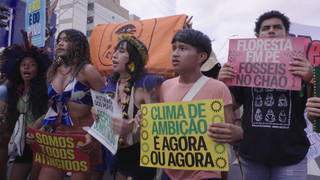
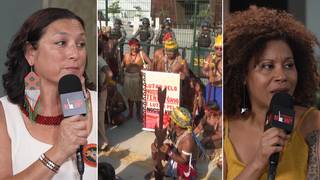
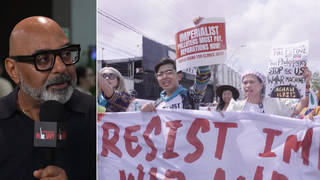
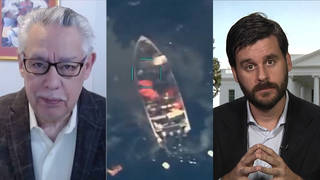





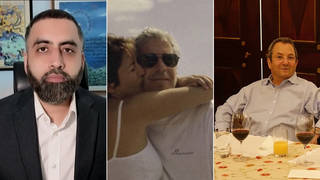
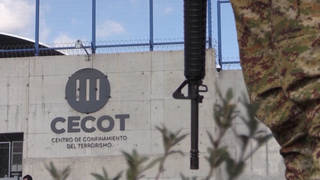
Media Options